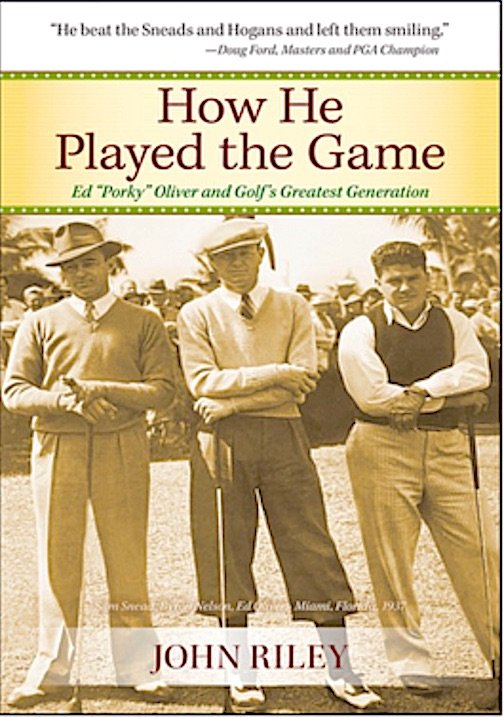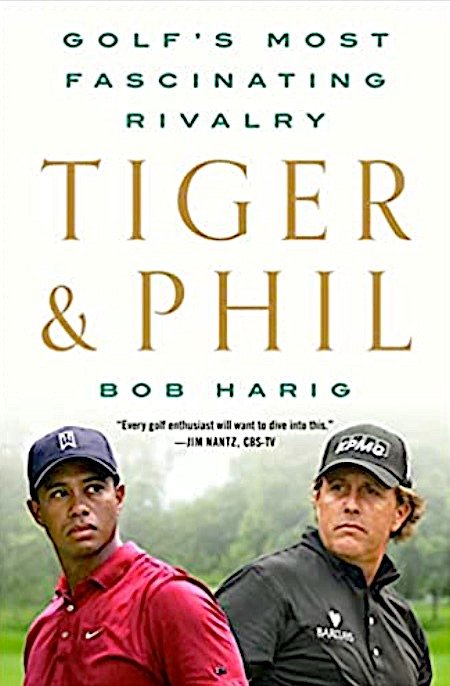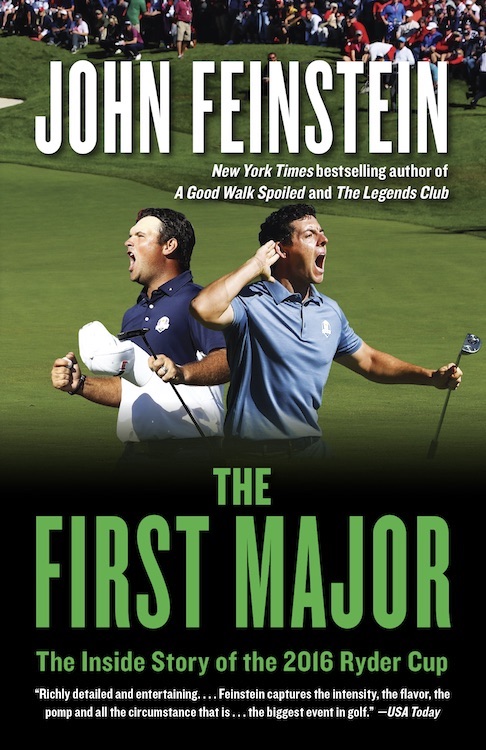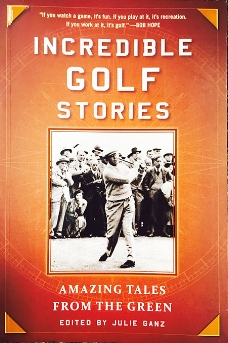HELLO TO ALL GOLF LOVERS…who enjoy having a collectible or two, no matter its heritage pedigree. The items that follow are available for purchase, ranging from art prints, autographed items, print collections such as LPGA and senior media guides, U.S. Open pairing brochures, Tiger Woods in print, plus posters, golf board games, major championship tournament programs, U.S. Amateur programs, bound set of Golf Digest, equipment items, periodicals, books. The process: Prices are listed, and if not, may be negotiated. Standard delivery shipping is extra. Images and additional details can be sent via email to interested party; please allow time for a response. All payments by PayPal or special arrangement. If interested in an item, contact Golf Heritage Society Region 1 member Cliff Schrock at clschrock2002@gmail.com or 203-260-9255 and leave a message. Priority on items given in the order communication is received.
Autographed items: Tommy Armour, How to Play Your Best Golf All the Time book, $80 (former library book). Paul Azinger, Cracking the Code book, $35. JoAnne Carner, 1983 Rail Charity Classic pairings guide, $35. Billy Casper, Golf Shotmaking book, $45. Jack Fleck, Olympian 2012 U.S. Open Preview Issue, $30. Corey Pavin, Corey Pavin’s Shotmaking book, $35. Ken Venturi, Tom Watson, on the 1994 National Awards Dinner program, Metropolitan Golf Writers Association, $60. Tom Watson, Ram visor, $50.
Framed Prints: Ben Hogan, Golf Digest cover, October 1960, 10th Anniversary issue, $20. Dave Stockton at the Masters, illustration for April 1970 Golf Digest, artist Cassell, $30. Punch magazine golf cartoon. Sept. 5, 1934, $30. Golf Works shop, Newark, Ohio, at Christmas, $20. Shadow box, generic golf collector theme, $25. The 11th at Augusta National, Donald Moss painting, Number 393 of 500, signed by Moss, printed 1984, has certificate of authenticity, $40.
Unframed prints: The Open Championship, A Decade of Champions, 1980-1989, $20. St. Andrews, course aerial, $25. The 12th at Augusta National, Donald Moss painting, artist’s proof inscribed by Moss, printed 1984, has certificate of authenticity, $20. The 13th at Augusta National, Donald Moss painting, No. 387 of 500 signed by Moss, printed 1984, has certificate of authenticity, $25. Lady Astor Playing Golf at North Berwick, by Sir John Lavery, $30. St. Andrews Lithograph Collection Plates, Limited, signed and numbered by Iain Macfarlane Lowe, $20 each: No. 1, copy 237 of 1,000, town of St. Andrews in distance; No. 3, copy 237 of 1,000, clubhouse, holes 1 and 18 night scene, Image Size: 24 x 18”; No. 4, copy 237 of 1,000, pair of greens and town; No. 5, copy 237 of 1,000, far end of course looking back to town; No. 6, copy 237 of 1,000, Road Hole green, 18th hole, clubhouse; Golf Digest, 50th anniversary poster, $10; Golf Digest: 3 Champions of the Modern Era, Hogan, Nicklaus, Watson, $10.
Figurine/Flag: Dan Jenkins bobblehead, $20; 2002 Open Championship hole flag (in plastic tube), $15.
Equipment (prices to be decided): Great Big Bertha II Driver; J’s Professional Weapon driver, circa 1990, made famous by Jack Nicklaus, Ray Floyd, Ozaki brothers; Ben Hogan wooden-head women’s driver; Louisville Golf The Classic Fifties Series persimmon driver; H&B Citation wooden-head driver.
Training aid: The Bickler putting device, $10.
Glassware: Champagne flute from Ben Hogan Room dedication, USGA museum, June 8, 1999, has slight chip on base, price to be decided
Printed Material…Golf Digest Bound Volume set, 1950 to present. Details: 1950 to 1959, 1963, 1968 to 2016 in bound form. Loose copies, 1960, 1961, 2017 to present. Not included: 1962, 1964 to 1967. Price/shipping to be negotiated. Includes index cards in electronic pdf form for subject matter for the years 1950 to 1999.
Printed Material…Tiger Woods Collection, all items sold as set: $400…Books listed by title, author, year published, hard back or paperback, publisher, original price. 36 Books: The Short Game Magic of Tiger Woods, John Andrisani, 1998 Crown HB, 18.00. The Tiger Woods Way, John Andrisani, 1997 Crown HB, 18.00. A-Game Golf, John Anselmo, 2001 Doubleday HB, 25.00. 18 Holes with Tiger, Beckett Publications staff, 1998, 24.95. Tiger Woods; Jeff Benedict and Armen Keteyian, Simon & Schuster 2018 PB. Tiger, Reflections on a Champion, edited by David LaFontaine, 1997 Dove Books PB, 6.95. Tiger Woods, Jack Clary, Smithmark Publishers, Belden Hill Press, 1997. In Every Kid there Lurks a Tiger, Rudy Duran, 2002 Hyperion HB, 23.95. Tiger Woods, An American Master, Nicholas Edwards, Scholastic PB, July 1997, 3.99. At the Turn, Steve Eubanks, 2001 Crown HB, 24.00. The First Coming, Tiger Woods: Master or Martyr?, Library of Contemporary Thought, John Feinstein, 1998 PB, 7.95. Tiger & Phil, Bob Harig, St. Martin’s Press, 2022 HB, 29.99. How Tiger Does It, Brad Kearns, McGraw Hill 2008 HB, 19.95. Tiger Woods, Golfing to Greatness, S.A. Kramer, 1997 Random House PB, 3.99. Stalking the Tiger, Vartan Kupelian, Sleeping Bear Press, HB. Unplayable, An Inside Account of Tiger’s Most Tumultuous Season, Robert Lusetich, Atria Books HB 2010, 26.00. The Open Championship, 2000, Bev Norwood editor, Hazleton HB (2 copies). The Open Championship, 2005, Bev Norwood editor, Hazleton HB (2). The Open Championship, 2006, Bev Norwood editor, Aurum HB (2). The Chosen One, David Owen, 2001 HB Simon & Schuster, 21.00. Tiger, Tiger: His Life, as It’s Never Been Told Before, James Patterson, HB Little, Brown, 2024, 32.99. Raising the Bar, Tim Rosaforte, Thomas Dunne HB 2000, 24.95. Tiger Woods, The Makings of a Champion, Tim Rosaforte, St. Martin’s July 1997 PB, 5.99. Tiger Woods, The Makings of a Champion, Tim Rosaforte, Thomas Dunne 1997 HB, 21.95. Tiger Woods, King of the Course, Jeff Savage, Lerner Publications Company, 1998 PB, 5.95. Quotable Tiger, Rich Skyzinski, Towle House 2001 HB, 14.95. Follow the Roar, Bob Smiley, HarperCollins 2008 HB, 25.95. Tiger Woods, The Making of a Champion, Sports Illustrated/John Garrity, Simon & Schuster 1996 HB, 20.00. 101 Little Known Facts about Tiger Woods, 1997 Sports Publishing Inc. PB, 6.95. Tiger by the Tale, A Celebration of Tiger Woods, Mark Stewart, Cronopio Publishing, 1997 PB, 14.95. Chasing Tiger, The Tiger Woods Reader, Edited by Glenn Stout, Da Capo Press 2002 PB, 15.00. Tiger, John Strege, 1997 HB Broadway, 25.00. Training a Tiger, Earl Woods, HarperCollins, 1997 HB, 18.00. How I Play Golf, Tiger Woods, with the Editors of Golf Digest, 2001, 34.95. Masters Annual 1997, 2005. Masters Players Guide 2006 (2). 54 Woods Periodicals: Augusta: April/May 2003 (Masters preview 2003). Cigar Aficionado: June 2008. Golf Digest: January 2000, April 2000, September 2000, January 2001 (Grand Slam trophies cover), October 2001, May 2002, February 2019. Golf Journal: June 2001, July 2002, Fall 2020. Golf Magazine: December 1997, October 2000, December 2003, February 2006, October 2006; April 2009, August 2019. Golf Monthly: March 2000, June 2000. Golf World: May 23, 1997; April 9, 1999; November 5, 1999; November 12, 1999; February 11, 2000; June 23, 2000; July 28, 2000; August 25, 2000; March 31, 2006 (Masters Preview); March 30, 2007. Golf World UK: September 2000. Golfweek: 4-16-2005, 6-21-2008 (U.S. Open coverage), 6-28-2008, March 29, 2013; May 17, 2013; June 2019. The Majors of Golf: 2006 Masters. Maximum Golf: April 2001. Media Guide 2007: The Open at Carnoustie. Men’s Vogue: Spring 2006. The Open Championship: 2007. Seasons (Carolina Preserve): Premier Issue 2008. Sports Illustrated: August 28, 2000; April 18, 2005; July 25, 2005; July 31, 2006; April 8, 2013. Time: August 14, 2000. Travel & Leisure Golf: July/August 2002, July/August 2003, November/December 2004. TV Guide: June 9-15, 2001, (set of four Woods covers). USGA Championship Annual 2008. Vanity Fair: February 2010, May 2010. New York Times, June 16, 2008, “Stumbling But Refusing to Fall, Woods Forces a Playoff,” Sports D section pages. New York Times, June 17, 2008, “ ‘The Greatest,’ Woods Puts Away Mediate in Sudden Death,” Sports D section pages. New York Times, June 19, 2008, “After a Big Victory, a Huge Loss for Golf,” Sports D section pages. USA Today, June 19, 2008, A and C section reporting on Tiger Woods’ leg injury at U.S. Open.
Other golf books: Listed by Author, Title, Publisher, Year, Hard back or Paperback, original price, dust jacket, condition. ARMOUR, TOMMY –– A Round of Golf with Tommy Armour, Simon & Schuster, 1959 HB, $3.95, DJ, good, former library book. BAKER, STEPHEN—How to Play Golf in the Low 120s, Prentice Hall, May 1963, $4.95, HB, DJ, good. BARKOW, AL –– Golf’s Golden Grind: A History of the PGA Tour, Burford Books, 2000 PB of ’74 original, $16.95, excellent. BARRETT, DAVID –– Miracle at Merion, Skyhorse Publishing, 2010 HB, DJ, $24.95, excellent. BOOMER, PERCY –– On Learning Golf, Alfred Knopf, 1983 HB of 1946 original, 14th printing, DJ, $13.95, good. CANFIELD, JACK –– Et al., Chicken Soup for the Golfer’s Soul and Golf Digest present the Golf Book, Health Communications Inc., 2009 PB, $14.95, excellent. CANNON, DAVID – Golf Courses/Fairways of the World, Rizzoli HB, 2006, DJ, $100, No. 97 of 6,000, excellent. COOK, KEVIN, editor – The Golf Book, Sports Illustrated, 2009 HB, SI Books, DJ, excellent, $20. DARWIN, BERNARD –– The Golf Courses of the British Isles, Storey Communications, reprint of 1910 original, 1988 HB, DJ, $35, excellent. DAVIS, MARTIN –– Ben Hogan, The Man Behind the Mystique, The American Golfer, 2002 HB, DJ, $60, excellent. DAVIS, MARTIN – Jack Nicklaus, Simply the Best!, The American Golfer, 2007 HB, DJ, $40, excellent. DAVIS, WILLIAM H. –– Great Golf Courses of the World, with the editors of Golf Digest, Golf Digest Book with Harper & Row, 1974 HB, DJ, $19.95, good. DAVIS, WILLIAM H. –– 100 Greatest Golf Courses, with the Editors of Golf Digest, Golf Digest book special 1986-1987 edition, 1986 HB, DJ, $29.95, excellent. DAVIS, WILLIAM H. –– 100 Greatest Golf Courses and Then Some, with the Editors of Golf Digest, Golf Digest book with Simon & Schuster, 1984 HB revised edition, DJ, price?, good. DIAZ, JAIME/HARTOUGH, LINDA–– Hallowed Ground, Golf’s Greatest Places, Greenwich Workshop Press, $45, 1999 HB, DJ, excellent. DOAK, TOM – The Confidential Guide to Golf Courses, 1996 Sleeping Bear Press HB, shrinkwrapped, sale price $100. DOAK, TOM – The Confidential Guide to Golf Courses, 1996 Sleeping Bear Press HB, $50. DODSON, JAMES –– Ben Hogan, An American Life, Doubleday, 2004 HB, DJ, $27.50, excellent. DONOVAN, RICHARD E. and MURDOCH, JOSEPH S.F. –– The Game of Golf and the Printed Word, 1566-1985, Castalio Press, 1988 HB, DJ, cardboard box cover, price unknown, good. FAY, MICHAEL J. –– Golf, As It Was in the Beginning, British Open, Universe Publishers, 2002(?) HB, shrinkwrapped, DJ, price unknown, excellent. FROST, MARK –– The Grand Slam, Bobby Jones, America and the Story of Golf, Hyperion, 2004 HB, DJ, $30, excellent. GLEASON, DAN –– The Great, the Grand and the Also-Ran, Random House, 1976 HB, DJ, $7.95, good. GOLF DIGEST –– Golf Digest: Golf’s Greatest Players, Courses and Voices, Hugh Lauter Levin Assoc., 2000 HB, DJ, green cover copy, inside plastic cover, $24.95, excellent. GOLF DIGEST –– The Golf Digest Trilogy, Wedge Book by Doug Ford, Driver Book by Sam Snead, Putter Book by Bob Rosburg, Golf Digest 1963 HBs, in boxed set, $3.95 each book, DJ, good. GRAUBART, JULIAN –– Golf’s Greatest Championship, The 1960 U.S. Open, Donald I Fine Books, 1997 HB, DJ, $24.95, excellent. The GREATER GREENSBORO OPEN, 1933-1988, 50th Anniversary Book, 1988, sale price $40, excellent. HOGAN, BEN –– Power Golf, Pocket Books, Nov. 2010 PB reissue of 1948 original. HOTELLING, NEAL –– Pebble Beach: The Official Golf History, Triumph, 2009 HB, DJ, $45, excellent. JENKINS, DAN –– The Dogged Victims of Inexorable Fate, Little, Brown 1 st edition, 1970, $5.95, HB, DJ has tears. JERRIS, RAND –– Golf’s Golden Age, National Geographic/USGA, 2005 HB, DJ, $27, excellent. JONES JR., ROBERT T. –– Bobby Jones on Golf, intro by Grantland Rice, foreword by Sidney L. Matthew, Sleeping Bear Press, 1997 PB of 1929 original, $29.95, excellent. MACKENZIE, ALISTER –– The Spirit of St. Andrews, Sleeping Bear Press, 1995 HB of 1933 original, DJ, shrinkwrapped, $20, excellent. MATTHEW, SIDNEY L. –– The History of Bobby Jones' Clubs, Impregnable Quadrilateral Press, 1992 HB, DJ, price?, good. MIDDLECOFF, CARY –– The Golf Swing, Prentice-Hall, 1974 HB, DJ, $7.95, good. MORRISON, ALEX J. – A New Way to Better Golf, Simon & Schuster, April 1946 HB. NELSON, BYRON –– How I Played the Game, Taylor Publishing, 1993 HB, $19.95, DJ, excellent. OBETZ, CHRISTOPHER, edited by –– 100 Classic Golf Tips, Universe Pub., 2007 HB, DJ, $24.95, excellent, shrinkwrapped. PLATTS, MITCHELL – The Illustrated History of Golf, Gramercy, 2000 HB with DJ, sale price $5. SKYZINSKI, RICH -- Quotable Hogan, Towle House, 2001 HB sale price $5. WIND, HERBERT WARREN—The Gilded Age of Sport, Simon & Schuster, HB, DJ, 1961, good, cellophane cover.
Periodicals: Golf Digest random: February 1973 Annual (Nicklaus LeRoy Neiman cover), July 1973, September 1974 (Snead cover), October 1974 (J.Miller cover), October 1981 (Snead “Sam’s Ageless Swing” cover), February 1983 Annual (T.Watson cover), September 2009 Arnold Palmer at 80 on cover, May 2014 (Paulina Gretzky cover), September 2014, July 2017, July 2018; Spring/Summer 1996 Golf Digest Lessons from Golf’s Greatest Swings. Golf Magazine random: April 1960 (brush up on the basics cover), August 1960 (Sam Snead instruction), September 1960 (Bobby Jones issue), June 1961 (Ben Hogan, The Six Opens Hogan Should Have Won!), July 1961 (Gene Sarazen cover instruction), August 1961 (six winning pro pointers), September 1961 (D Day at Pebble Beach, the Amateurs are coming), January 1962 (Snead-Hogan cover), June 1962 (Ben Hogan cover), May 1962 (Snead’s half century), October 1976 (Jan Stephenson cover). Golf Illustrated UK, September 26, 1913 (fair, U.S. Open reporting on Ouimet). Golf Illustrated U.S., November 1931 (good, Tillinghast); January 1932 (good, Tillinghast). Golf World random: July 28, 2014, McIlroy wins Open, final print copy of Golf World; October 29, 1999, Payne Stewart death; January 17, 1997, 50th Anniversary; September 29, 1995, Europe wins Ryder Cup; July 28, 1995, John Daly wins The Open; Golf World 1987 Famous Golf Swings. Golfdom September 1967 issue. Golfers Magazine random, December 1930 (Glenna Collett cover, Jones retires, cover not attached); January 1931 (Leo Diegel cover, good); March 1931 (Hagen cover, fair, both covers present but not attached). MacFadden Publication: Bobby Jones on Golf (1929-1930, fair, spine deteriorating but still intact, back cover missing? New York Times newspaper coverage of Annika Sorenstam playing Colonial. Sport magazine, December 1986, 40th Anniversary, The 40 Who Changed Sports (includes Palmer, Nicklaus articles). The Sun Dial Press: Sam Snead’s Quick Way to Better Golf (1938, former library). Time, June 6, 1938 (good, Johnny Goodman cover). Trump National Golf Club, Bedminster, New Jersey, visitor brochure, undated. University of Houston 1978 media guide. USGA Journal, September 1948 Pebble Beach cover; March 1970 De Vicenzo cover. Vanity Fair, July 1999 photo portfolio of “Green Giants”.
Sports Illustrated products: Swimsuit edition anniversary issues: 25th (1989), 40th (winter 2004), 50th (winter 2014) Sports Illustrated, August 11, 2014 The 60th Anniversary Issue (2 copies). September 27, 2004 The 50th Anniversary Issue. 1989 Special Issue, 35th Anniversary. 1989 Special Issue, 35 Years of Covers. July 14/21, 2003 50th Anniversary The Way We Were (2 copies). 2004 Special Issue, The Pictures: 50 Years of SI Photography (2 copies). Ryder Cup coverage October 4, 1999, Justin Leonard on cover, (2 copies). September 29, 1999 Looking Back, a 20th Century Celebration. July 26, 1999 The Century’s Greatest Sports Photos. August 13, 1979, Silver Anniversary Issue, cover torn and detached but repaired. December 23, 1974, Muhammad Ali cover, Sportsman of the Year. SI Classic…Fall 1992, The Amazing Mays, SI Presents the All-Time Dream Teams (Ben Hogan and Jules Alexander photos). Sports Illustrated Presents series…Baseball’s 20 Greatest Teams of All Time, 1885 White Stockings to 1989 Athletics, published 1991; The Champs! 1996 New York Yankees.
Tournament programs: Bob Hope Chrysler Classic Tournament Program, 30th Annual, 1989, good condition. Bob Hope Chrysler Classic Tournament Program, 2009, Celebrating 50 Years of Hope, good condition. Carling World Golf Championship, 1966 Royal Birkdale. Chrysler Cup program, Golfiana 1991. Colgate-Hall of Fame Classic, Pinehurst Country Club program, 1977 (2 copies), 1979, 1980. The Crosby/AT&T Pro-Am programs, 1963, 1978, 1984, 1990. GTE Byron Nelson Classic, 1995, 50th Anniversary. J&B Scotch Pro-Am, 1982 (2 copies). J&B Scotch Pro-Am, LPGA, 1983 program, good, cover separated from inside. Legends of Golf Tournament programs 1978, 1980, 1982, 1983, 1984, 1985, 1987, 1989, 1990, 1997. Liggett & Myers Open/U.S. Professional Match Play Ch., 1972, CC of North Carolina. Masters Players Guide, 2011 (Mickelson cover). Masters Journal, 1994, 1998 Jones cover), 2004 (Palmer), 2009, 2010, 2011, 2012, 2014, 2015. Memorial Tournament, 1988 to 2017, missing years 1993 and 2000 in that span. NCAA Golf Championship, 1974. The Open Championship program 1977 Turnberry, 1981 Royal St. George’s Golf Club, 1982 Royal Troon, 1984 St. Andrews Open Ch. (1986, 1989, 1991-1994, 1996-1999, 2002, 2005, 2007), Open Ch. Annuals (1984-1987, 1993, 1997, 1999-2002, 2005, 2006, 2010, 2016). PGA Annuals (1916-1984 (1 volume), 1985, 1996, 1998-2000). PGA Championship program, 1961, Olympia Fields, good condition; 1969, 1976, 1979, 1980, 1992 Bellerive, 2016 Baltusrol. U.S. Open Championship program 1956, Oak Hill, 1974, 1976 to 1979, 1981, 1984 to 1993, 1996 to 1998, 2001 to 2004, 2006 to 2012, 2016 (2 copies), 2017. PGA Tour media guides…1950 Official PGA Tournament Record Book, PGA of America; 1951 Official PGA Tournament Records, 1952 Official PGA Tournament Record Book, PGA of America; 1954 Official PGA Tournament Record Book, PGA of America; 1959-1964 Official PGA Tournament Record Book, PGA of America. LPGA Tour media guides, 1959-1963, 1965-1067 Wilson Women’s Golf; 1963 MacGregor women’s guide; 1964-1966, 1968-2008 LPGA Tour guides and 2012 Player Guide. (Final guide in mass print distribution was 2008.). Single LPGA Tour media guide, 2008. Senior PGA (Champions) Tour media guides, 1981-2016 (final guide in mass print distribution). Phoenix Open 50th Anniversary Program, 1985, good condition, faint “library” scrawl on cover. Porter Cup, 1975 program.Ryder Cup programs, 1951 Pinehurst, 1987, 1999 The Country Club, 2014. Sahara Invitational 1964 program. U.S. Amateur, 2003, 2004 (Winged Foot). U.S. Senior Open, 1990 (Ridgewood), 1993. World Cup 1976, 1977. World Series of Golf 25th anniversary 1986 program. National Baseball Hall of Fame and Museum 2002 yearbook. Commemorative Edition, St. Louis Cardinals, World Champions 2006. National Golf Foundation, Speedy Golf program pamphlet, 1969 Edition. National Golf Foundation, Play Golf in Our Intramural Tournament, The Game of a Lifetime, undated.
Major championship Pairing Sheets/Pamphlets/Scorecards/Spectator Guides: 2016 PGA, Round 3…1970 U.S. Open, Rounds 3 and 4…1975 U.S. Open, Round 4…1983 U.S. Open, Rounds 1 and 2…1986 U.S. Open, Rounds 1, 2 and 3…1988 U.S. Open, Rounds 1, 2 and 3…1991 U.S. Open, Rounds 1, 3 and 4 (2 copies)…1993 U.S. Open, Rounds 2, 3 and 4…1994 U.S. Open, Rounds 2 and 4…1995 U.S. Open, Rounds 1, 2 and 3…2002 U.S. Open, Practice and Round 1…2003 U.S. Open, Practice and Rounds 1, 2, 3 and 4…2005 U.S. Open, Rounds 1, 2, 3 and 4…2006 U.S. Open, Practice and Round 2…2007 U.S. Open, Rounds 1, 2, 3 and 4...2009 U.S. Open, Practice rounds…2010 U.S. Open, Rounds 1, 2, 3, and 4…2014 U.S. Open, Rounds 1, 2, 3, and 4. U.S. Open official score cards, 1986 Shinnecock Hills, 1988 The Country Club, 1989 Oak Hill East, 1990 Medinah CC No. 3, 1991 Hazeltine National, 1993 Baltusrol. Spectator guides, 1998 Players Championship, 25th Anniversary; U.S. Opens 1965, 1970, 1977, 1988, 1991, 1993, 1995, 2000, 2016; Yardage Book, 2016, The 145th Open Royal Troon.
Games: Board: The Penfold Golf Game (The Old Course, St. Andrews, 1978, G.S. Meubel International Ltd., Lanarkshire, Scotland. Board: Monopoly Golf Edition, still shrink-wrapped, 1998. Board: Challenge Golf at Pebble Beach, 3M Company, 1972, missing 4-5-6/13-14-15 sheet; has sheets for 1-2-3/16-17-18 and 7-8-9/10-11-12. GOLO Dice Game/Pouch.
VHS tapes: 1997 Masters. The Wide World of Golf Video Magazine, January/February 1990, Video Magazines International, ABC/Jack Nicklaus Productions Inc. 1977 Open Championship IPC Video. 1982 Open Championship IPC Video. Shell’s Wonderful World of Golf Match, Hogan v. Snead, shrinkwrapped, PGA Tour Productions.Shell’s Wonderful World of Golf Match, Littler v. Nelson, shrinkwrapped, PGA Tour Productions. Golden Greats of Golf by Golf Digest. The Golf Classic, I Love Lucy The Golf Game episode, The Honeymooners The Golfer episode, 1990 CBS/Fox Video.
DVD: 2001 Masters. The Drill System for Better Golf, with Jim McLean, 2006. The Ben Hogan Collection, Three-Disc Collection, 2006.
TO COME: Ball markers, paperweight, et al.















![WoodsThe1997Masters[HC].JPG](https://images.squarespace-cdn.com/content/v1/589913389f74566a01585d19/1491594418364-HZYIV2XJSG16S71NSI9Q/WoodsThe1997Masters%5BHC%5D.JPG)
